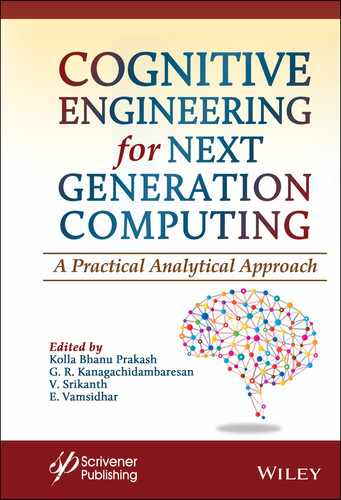The cognitive approach to the IoT provides connectivity to everyone and everything since IoT connected devices are known to increase rapidly. When the IoT is integrated with cognitive technology, performance is improved, and smart intelligence is obtained. Discussed in this book are different types of datasets with structured content based on cognitive systems. The IoT gathers the information from the real time datasets through the internet, where the IoT network connects with multiple devices. This book mainly concentrates on providing the best solutions to existing real-time issues in the cognitive domain. Healthcare-based, cloud-based and smart transportation-based applications in the cognitive domain are addressed. The data integrity and security aspects of the cognitive computing main are also thoroughly discussed along with validated results.
Table of Contents
- Cover
- Title Page
- Copyright
- Dedication
- Preface
- Acknowledgments
- 1 Introduction to Cognitive Computing
- 1.1 Introduction: Definition of Cognition, Cognitive Computing
- 1.2 Defining and Understanding Cognitive Computing
- 1.3 Cognitive Computing Evolution and Importance
- 1.4 Difference Between Cognitive Computing and Artificial Intelligence
- 1.5 The Elements of a Cognitive System
- 1.6 Ingesting Data Into Cognitive System
- 1.7 Analytics Services
- 1.8 Machine Learning
- 1.9 Machine Learning Process
- 1.10 Machine Learning Techniques
- 1.11 Hypothesis Space
- 1.12 Developing a Cognitive Computing Application
- 1.13 Building a Health Care Application
- 1.14 Advantages of Cognitive Computing
- 1.15 Features of Cognitive Computing
- 1.16 Limitations of Cognitive Computing
- 1.17 Conclusion
- References
- 2 Machine Learning and Big Data in Cyber-Physical System: Methods, Applications and Challenges
- 3 HemoSmart: A Non-Invasive Device and Mobile App for Anemia Detection
- 4 Advanced Cognitive Models and Algorithms
- 5 iParking—Smart Way to Automate the Management of the Parking System for a Smart City
- 6 Cognitive Cyber-Physical System Applications
- 6.1 Introduction
- 6.2 Properties of Cognitive Cyber-Physical System
- 6.3 Components of Cognitive Cyber-Physical System
- 6.4 Relationship Between Cyber-Physical System for Human–Robot
- 6.5 Applications of Cognitive Cyber-Physical System
- 6.6 Case Study: Road Management System Using CPS
- 6.7 Conclusion
- References
- 7 Cognitive Computing
- 8 Tools Used for Research in Cognitive Engineering and Cyber Physical Systems
- 9 Role of Recent Technologies in Cognitive Systems
- 9.1 Introduction
- 9.2 Natural Language Processing for Cognitive Systems
- 9.3 Taxonomies and Ontologies of Knowledge Representation for Cognitive Systems
- 9.4 Support of Cloud Computing for Cognitive Systems
- 9.5 Cognitive Analytics for Automatic Fraud Detection Using Machine Learning and Fuzzy Systems
- 9.6 Design of Cognitive System for Healthcare Monitoring in Detecting Diseases
- 9.7 Advanced High Standard Applications Using Cognitive Computing
- 9.8 Conclusion
- References
- 10 Quantum Meta-Heuristics and Applications
- 11 Ensuring Security and Privacy in IoT for Healthcare Applications
- 11.1 Introduction
- 11.2 Need of IoT in Healthcare
- 11.3 Literature Survey on an IoT-Aware Architecture for Smart Healthcare Systems
- 11.4 IoT in Healthcare: Challenges and Issues
- 11.5 Proposed System: 6LoWPAN and COAP Protocol-Based IoT System for Medical Data Transfer by Preserving Privacy of Patient
- 11.6 Conclusion
- References
- 12 Empowering Secured Outsourcing in Cloud Storage Through Data Integrity Verification
- Index
- End User License Agreement
